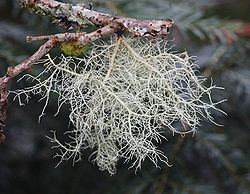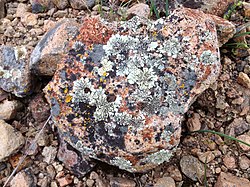
The following outline provides an overview of and topical guide to lichens.
Contents
- Descriptions of lichens
- Nature of lichens
- Morphology
- Ecology
- Types of lichens
- Lichen taxonomical classifications
- Lichens, by growth form
- Lichens, by substrate
- Lichens, by region
- Photobiont
- Lichen metabolites
- Study of lichens
- Threats
- Lichens in culture
- Lichen organizations
- See also
- Citations
- References
- External links
Lichens are composite organisms made up of multiple species. They comprise a fungal partner, one or more photosynthetic partners, which can be either green algae or cyanobacteria, and, in at least 52 genera of lichens, a yeast. [1] In American English, "lichen" is pronounced the same as the verb "liken" ( /ˈlaɪkən/ ). In British English, both this pronunciation and one rhyming with "kitchen" ( /ˈlɪtʃən/ ) are used. [2]









